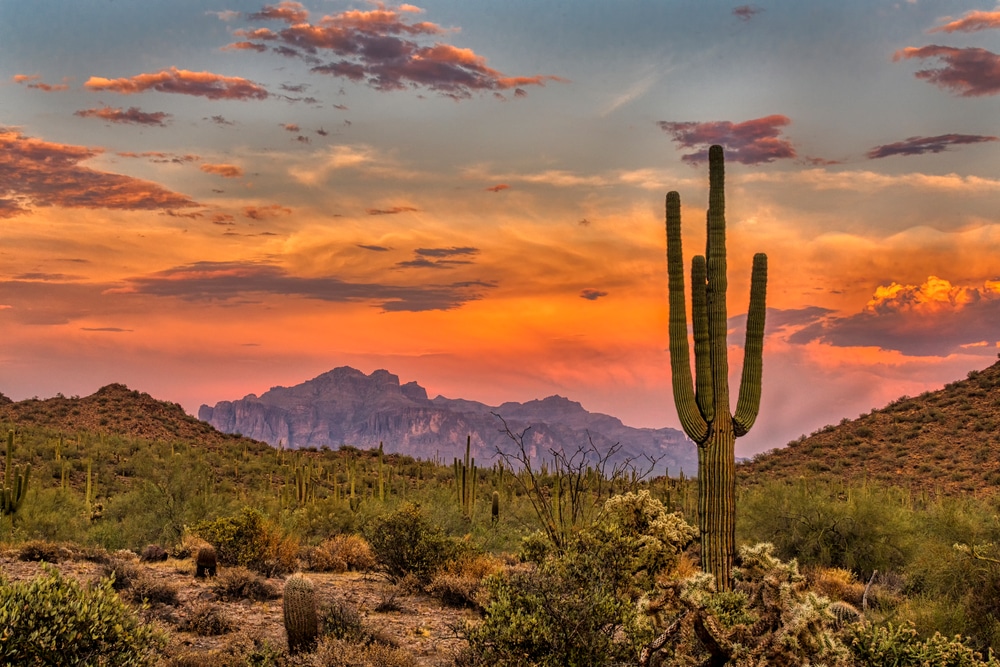The most impactful experience I have had in a desert ecosystem was my trip through Saguaro National Park. It has been one of my lifelong goals to document the Saguaro cacti. An ancient variety of cactus, some dating back 200 years! It is a unique type of old-growth forest and quite awe inspiring. These long-lived cacti can grow to over 46 ft tall, and provide habitat for so much wildlife.
Arid desert gardens have always been my favorite garden design. These landscapes are not only easy to maintain but also showcase unique varieties of desert plants, making them a stunning addition to any outdoor space.
I wanted to create a guidebook to help better understand desert plants in their native habitat. And the best ways to bring them into your backyard landscape. So here is my guide to desert plants. You will learn all about desert plant types, their adaptations, and desert gardening tips so you can create a unique arid ecosystem.
Overview Of Desert Ecosystems
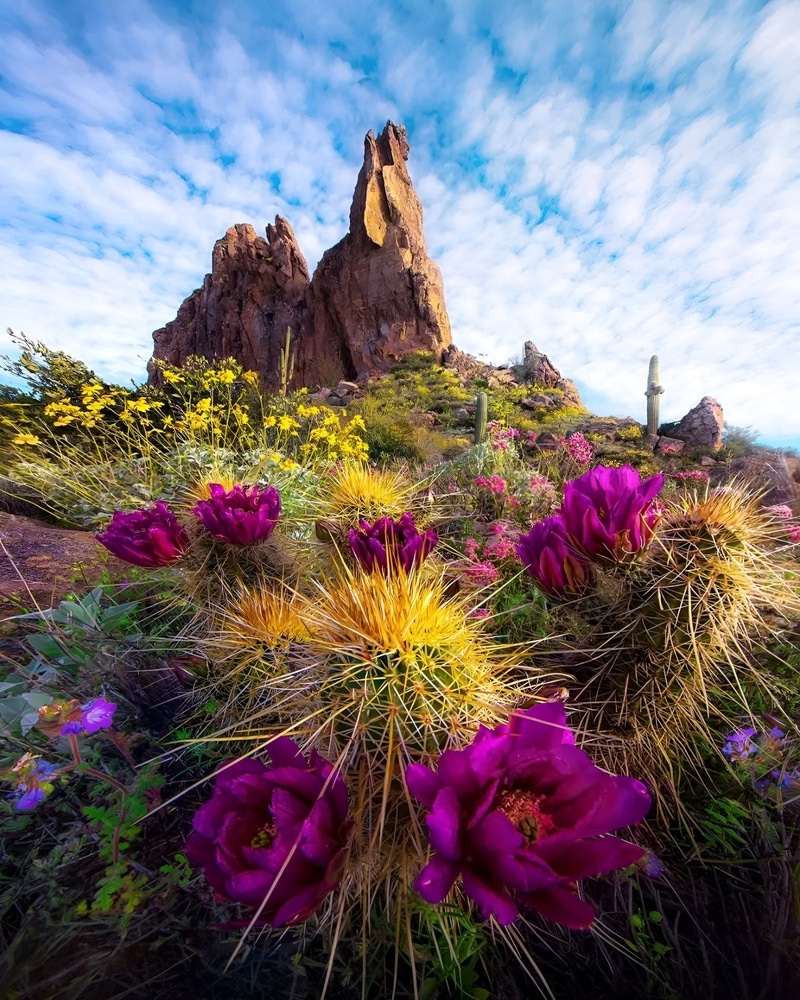
Did you know that desert ecosystems cover a total of 1/5th of the earth’s surface?! There are different types of desert biomes and they include:
- Hot and dry deserts
- Semi-arid deserts
- Coastal deserts
- Cold deserts
You might think a cold desert wouldn’t exist but Antartica is one!
Desert ecosystems are harsh and dry landscapes with very little rainfall. These ecosystems tend to have drastic temperature fluctuations, making these areas hard for plants to survive in. Desert soil classifications range from sandy gravel to stoney conditions. Specific desert flora and fauna have evolved to adapt to these harsh arid climates.
What Are Desert Plants?
There is an amazing range of drought-tolerant desert flora that has adapted to survive the harsh. arid ecosystems. They are also called xerophyte plants. They require little rainfall to survive and have the ability to store water in their leaves and plant tissue. Desert plants are typically leafless, and have spines and deeper root systems.
Adaptations Of Desert Plants
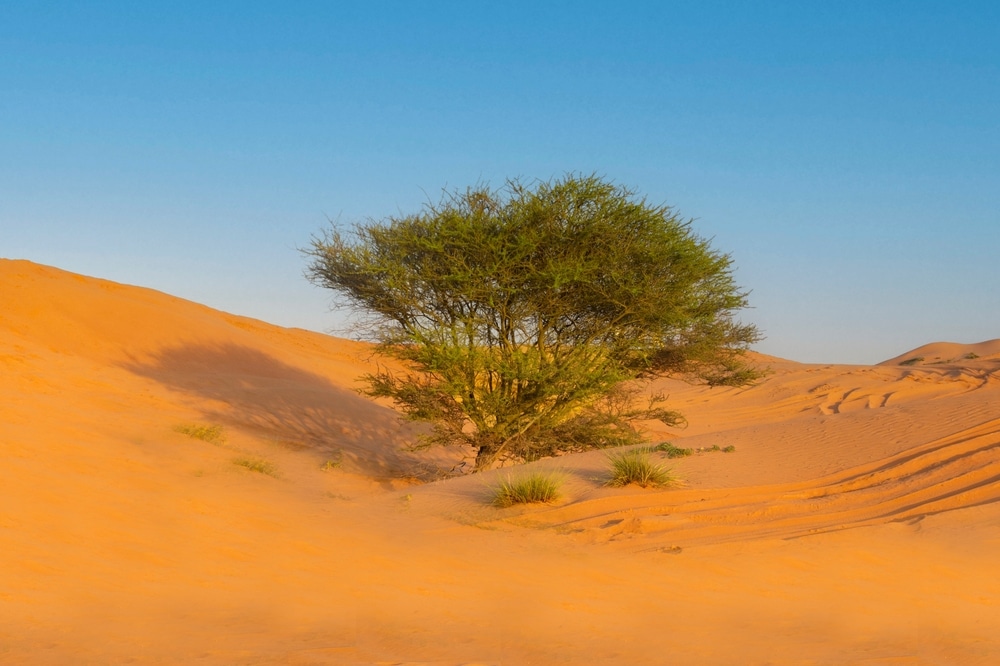
Dealing With Drought
Desert plants’ behavioral adaptations have evolved over millennia to deal with drought. They have developed certain mechanisms that allow them to undergo long periods without water. One way they deal with drought is their water storage mechanism. Some store water in their leaves, and some have thick skin to retain moisture. If the desert plant has leaves, they are typically small. This is because the small leaf size helps mitigate against evaporation by having less surface area.
Let’s dive deeper into each behavioral adaptation desert plants use to survive in desert climates.
Water Storage Mechanisms
Some desert plants have developed water storage mechanisms that help them conserve water. These plants include cactus and succulents. Their storage mechanisms allow them to go long periods without water. The adaptation works by allowing them to store water in their plant tissue which they are able to draw on during harsh times. They have also developed prickly spines, to deter animals from drinking their water reserves!
Leaf Adaptations
Leaf adoption of desert plants helps to reduce evaporation and conserve water during the heat of the day. Some of these adaptations include leafless plants. An example of this is succulent or cactus. These plants instead have tick pads that help to retain water in the plant. Plants that do have leaves tend to be small. An example of this is crape myrtle, with its small ovate leaf shape.
Adapted Photosynthesis In Desert Plants
Certain types of desert plants have adapted their photosynthesis process to occur at nighttime instead of the day. These plants include varieties of cacti and succulents. This adaptation works to conserve water and correlates with nighttime pollinators.
Photosynthesis in the daytime in the hot desert would cause a higher water loss percentage through transpiration and evaporation. Desert plants have solved this problem by opening their stomata at night, which helps to conserve water loss because the temperatures are lower. The stomata are pores found in the skin and other organs of the plant that help in the chemical exchange process of photosynthesis. This adaptation helps to reduce water evaporation and allows the plants to absorb and conserve water. It’s an impressive evolution!
Reproductive Adaptation
Desert plants have also evolved to support nocturnal pollination sources. Bats and moths are examples of the types of pollinators these flowers are attracting. Nighttime photosynthesis co-evolved along with nocturnal pollinators. By photosynthesizing at night while also attracting nocturnal pollinators, these plants increase their chances of survival.
Structural Adaptations
Structural adaptations of desert plants include the development of spines on the plant’s surface. Interestingly, the spines are used to displace wind to protect the pads from drying out and cracking.
Other structural adaptations include root development. Some plants have evolved deep root systems that reach for water deep in the earth. Other desert plants have root systems that spread out along the surface. This tactic is to absorb as much water from rain as possible.
Types Of Desert Plants
Typically, the qualities a desert plant needs to thrive are well-drained, sandy, gravel or rocky soil. They love to be in full sun and require minimal watering. They are resilient and thrive in harsh environmental growing conditions. Below you’ll find the specific care and maintenance needs in the information tables of each of the different desert plants.
Here’s some of my favorites.
Cacti & Succulents
Beavertail Cactus

| Beavertail Cactus | Care Information |
|---|---|
| Origin | The Mojave and Sonoran deserts, California, Nevada, Arizona, Utah |
| Plant size | 11 inches height x 5 ft wide (27.94 x 152.4 centimeters) |
| Flowering | March through june |
| Light | Full sun |
| Watering | Once every 3 weeks |
| Fertilizer | None |
| Potting soil | Quick draining, sandy gravel |
| Pruning | None |
| Repotting | Slow growing |
| Toxicity | None |
Soaptree Yucca
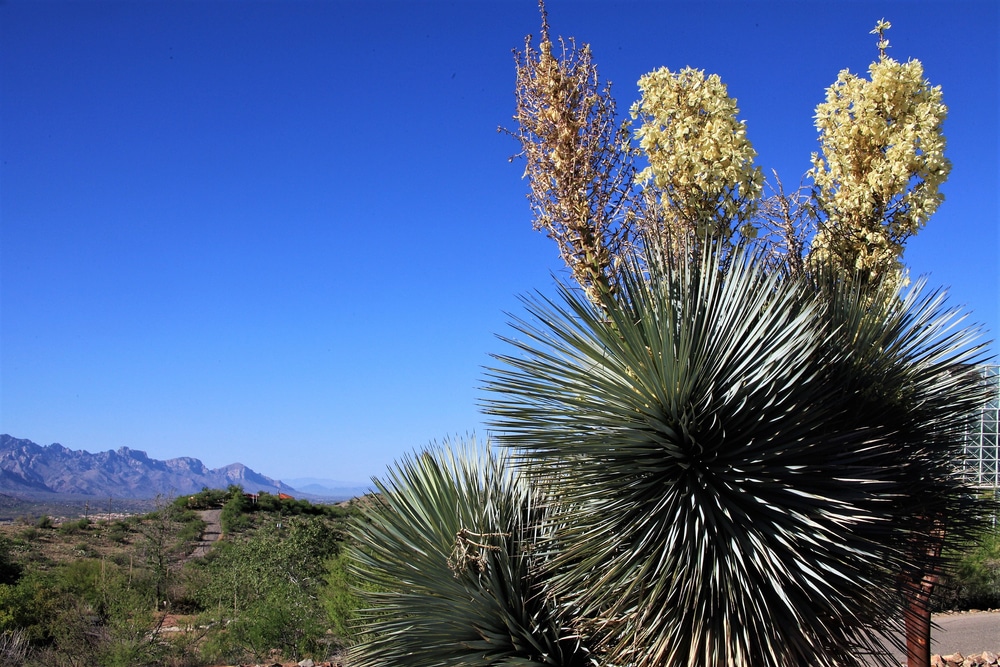
| Soaptree Yucca | Care Information |
|---|---|
| Origin | Mid-Arizona, New Mexico, Western parts of Texas |
| Plant size | 18 feet tall (5.49 meters) |
| Flowering | Spring- fruiting into the summer |
| Light | Full sun |
| Watering | Minimal |
| Fertilizer | None |
| Potting soil | Sandy or loamy soil |
| Pruning | None |
| Repotting | When you see roots matted on top of the soil |
| Toxicity | None |
Century Plant
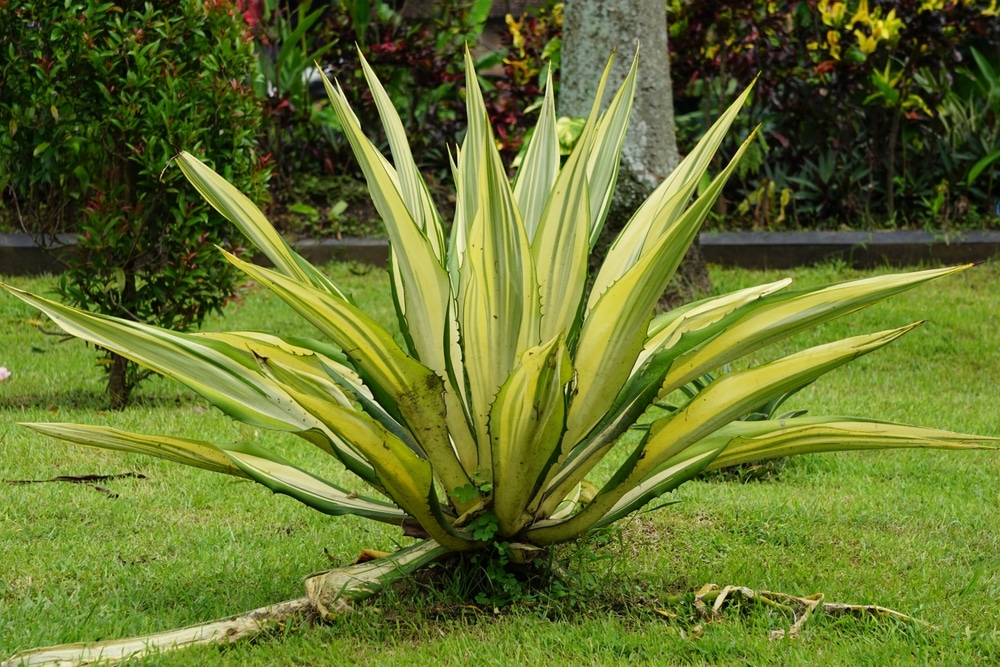
| Century Plant | Care Information |
|---|---|
| Origin | Southern California, Texas and Mexico |
| Plant size | Ground plant with stalk that measures 25 feet (7.62 meters) |
| Flowering | June through august |
| Light | Full sun but withstand part shade |
| Watering | Minimal |
| Fertilizer | None |
| Potting soil | Sandy soil |
| Pruning | None |
| Repotting | Every other year |
| Toxicity | Toxic to humans and animals |
Saguaro Cactus
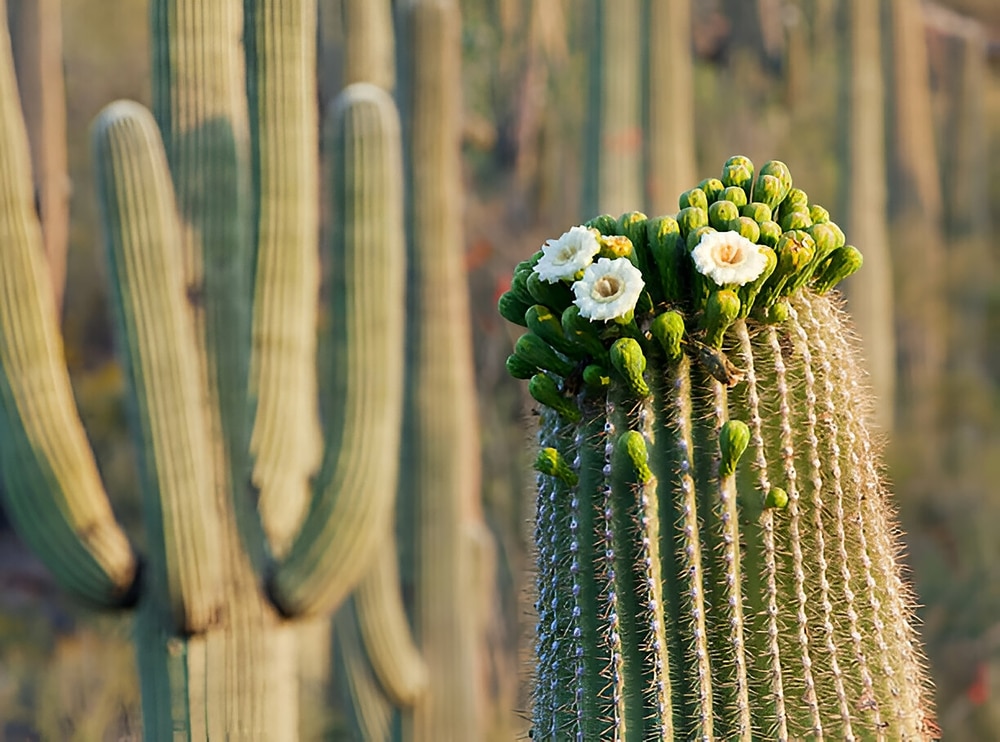
| Saguaro Cactus | Care Information |
|---|---|
| Origin | Dry parts of California, Arizona and mexico. Their range only extends to about 4,000 ft above the sea. Therefore, they are only located in small pockets within the southern part of the states and a small area in Sonora, Mexico |
| Plant size | Can grow up to 46 feet (14.02 meters) tall and can live for almost 200 years. |
| Flowering | White flowers on crown |
| Light | Full sun |
| Watering | Minimal |
| Fertilizer | None |
| Potting soil | Well drained sandy soil |
| Pruning | none |
| Repotting | Slow growing. Pot up as it grows. |
| Toxicity | Not toxic |
Hedgehog Cactus
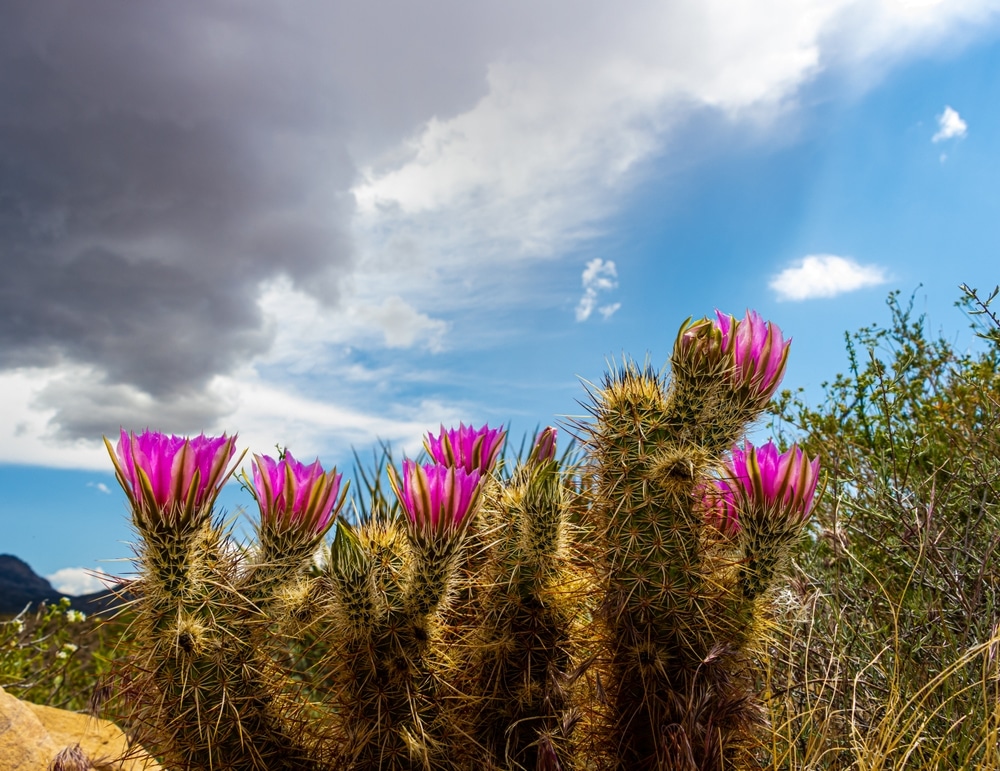
| Hedgehog Cactus | Care Information |
|---|---|
| Origin | Southern California |
| Plant size | 1 – 3 feet tall (0.3 – 0.9 meters) |
| Flowering | Bright red flowers that bloom at nightOnly blooms for 5 days |
| Light | Full sun |
| Watering | Minimal |
| Fertilizer | None |
| Potting soil | Well drained sandy soil |
| Pruning | None |
| Repotting | Slow growing. Repot as it grows |
| Toxicity | Edible- produces fruits that birds eat and other wild animals |
Fishhook Cactus
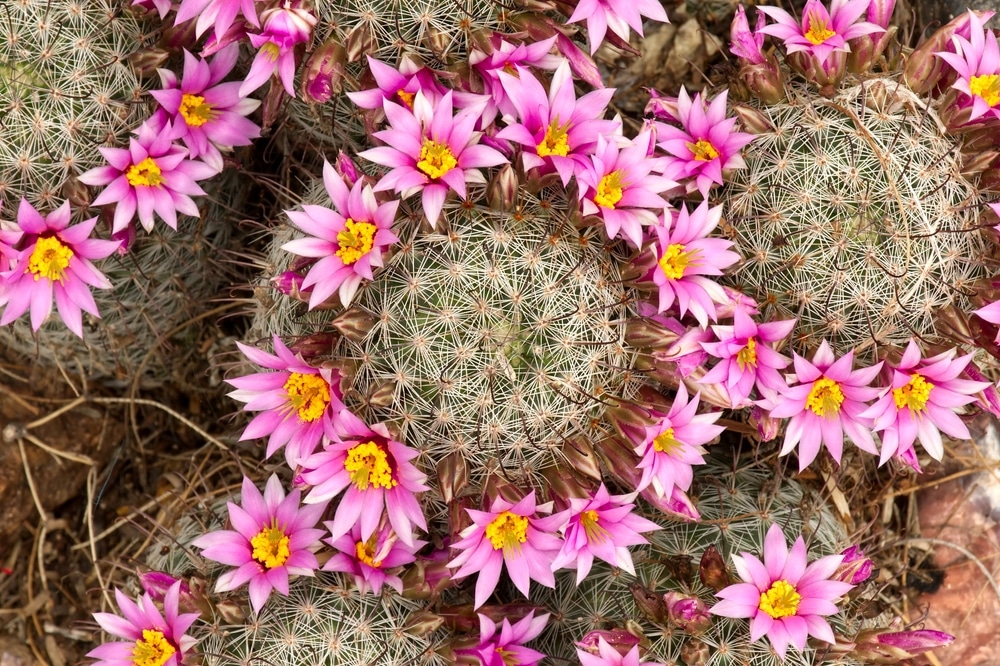
| Fishhook Cactus | Care Information |
|---|---|
| Origin | New Mexico, Texas, Arizona, California |
| Plant size | 5 inches (12.7 centimeters) tall |
| Flowering | September through October |
| Light | Full sun |
| Watering | Minimal |
| Fertilizer | Non |
| Potting soil | Well drained sandy soil |
| Pruning | None |
| Repotting | Slow growing. Repot as it grows |
| Toxicity | Toxic to humans and animals |
Senita Cactus
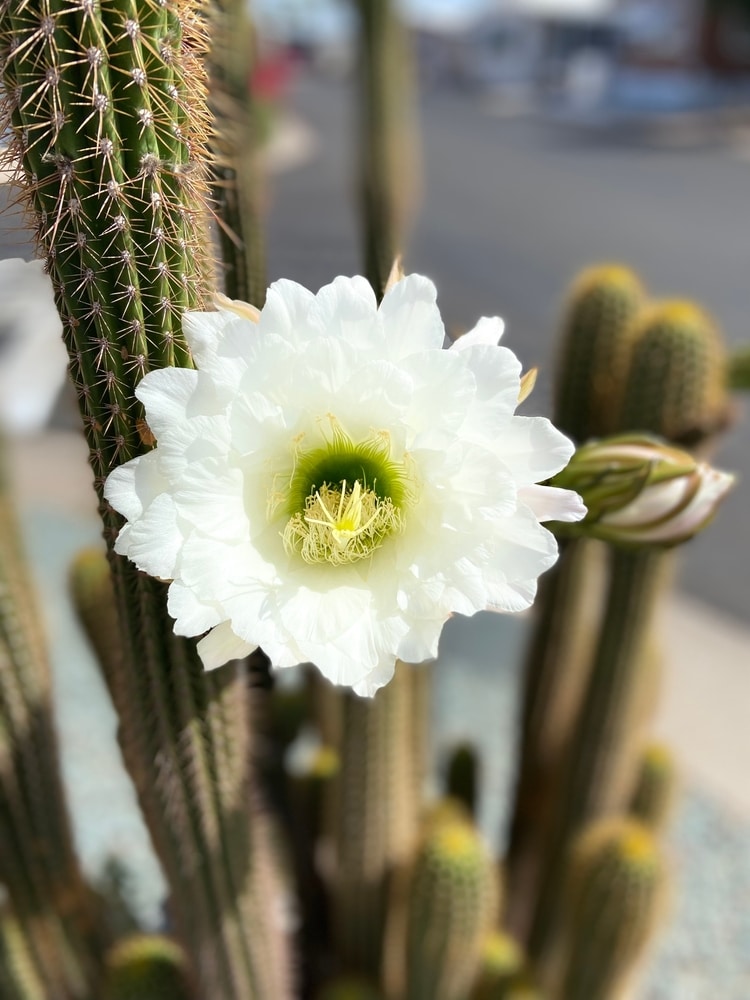
| Senita Cactus | Care Information |
|---|---|
| Origin | Rocky hillsides of Sonoran desert |
| Plant size | 25 ft (7.62 meters) tall |
| Flowering | Pale red and pink flowers |
| Light | Full sun |
| Watering | Minimal |
| Fertilizer | None |
| Potting soil | Dry rocky soil |
| Pruning | None |
| Repotting | Every 2-3 years |
| Toxicity | Edible fruits |
Agave
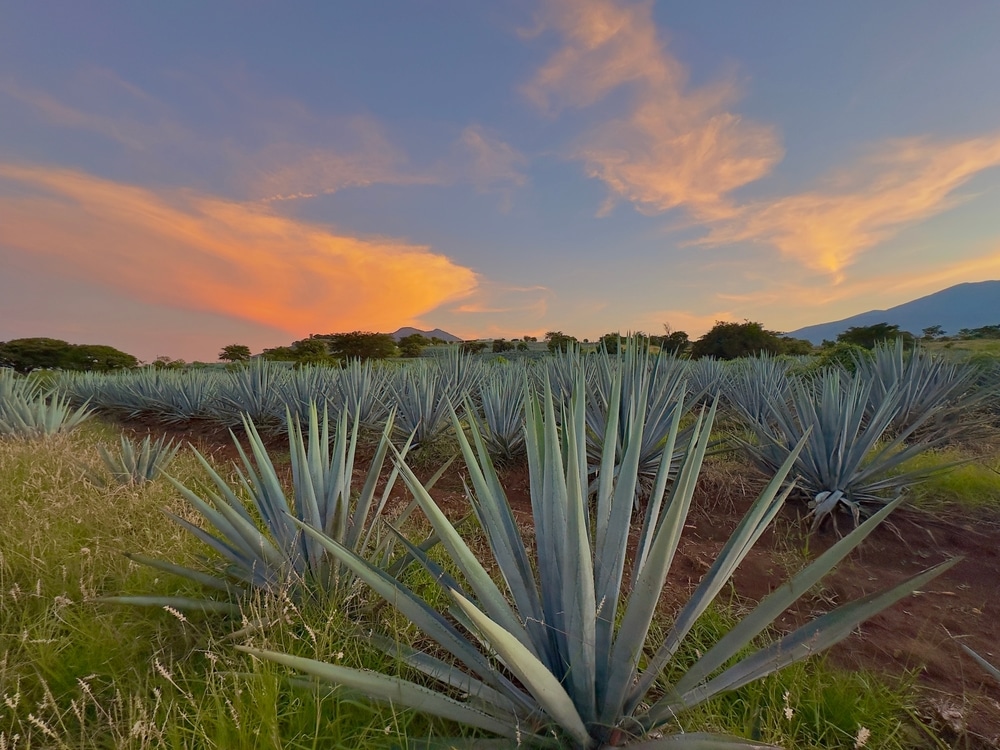
| Agave | Care Information |
|---|---|
| Origin | Mexico and the southwestern United States, particularly the deserts of Mexico, Arizona, and Texas |
| Plant size | 3-5 feet (0.9-1.5 meters) tall |
| Flowering | Tall flower stalks with tubular yellow, orange, or red flowers |
| Light | Full sun |
| Watering | Minimal |
| Fertilizer | None |
| Potting soil | Dry rocky soil |
| Pruning | None |
| Repotting | Every 2-3 years |
| Toxicity | Not toxic |
Varieties And Uses
There are three types of Agave that are a part of traditional medicine. Agave tequilana, Agave angustifolia, and Agave americana are anti-inflammatory. Their sap is used to treat inflammation. Agave tequilana Weber is also used in the making of Tequila. This is the only variety used in the making of tequila!
Aloe

| Aloe | Care Information |
|---|---|
| Origin | Arabian Peninsula, Africa, and parts of the Mediterranean |
| Plant size | 1-3 feet (0.3-0.9 meters) tall |
| Flowering | Tubular flowers that range in color from orange to red or yellow |
| Light | Full sun |
| Watering | Minimal |
| Fertilizer | None |
| Potting soil | Dry rocky soil |
| Pruning | Remove dead or dying leaves |
| Repotting | Every 1-2 years |
| Toxicity | Generally safe for humans but can be toxic to pets, especially cats and dogs, if ingested |
Varieties And Uses
Aloe vera is the most common type of aloe used for medical purposes. This desert plant is anti-inflammatory and very soothing. Other varieties used this way are Aloe perryi, Aloe ferox, and Aloe arborescens. Aloe is most commonly used for treating sunburns.
Ocotillo
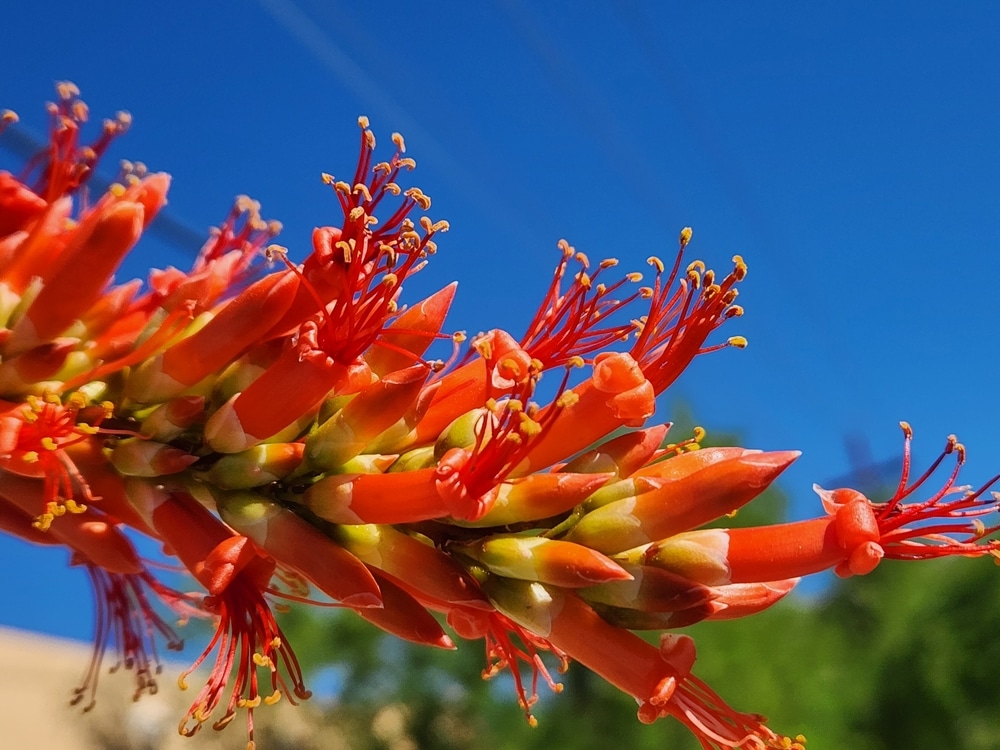
| Octillo | Care Information |
|---|---|
| Origin | Southwestern United States, Sonoran and Chihuahuan deserts, and parts of northern Mexico |
| Plant size | 10-20 feet (3-6 meters) tall |
| Flowering | Bright red tubular flowers |
| Light | Full sun |
| Watering | Minimal |
| Fertilizer | None |
| Potting soil | Dry rocky soil |
| Pruning | Remove dead or dying leaves |
| Repotting | Every 2-3 years |
| Toxicity | Not toxic |
Unique Characteristics And Uses
Ocotillo was once the bane of my existence as I hiked up a desert mountain in New Mexico! These plants are huge, gaining heights up to 20 ft. The plant’s long cacti-like pads are covered in sharp barbs. Which hurt a lot of you trying to hike around them! These barbs are a defense mechanism, used to conserve water by deterring wildlife and birds. This plant is used as a natural fencing as its sharp spines deter wildlife and humans from passing.
Desert Grasses, Trees & Shrubs:
California Fan Palm
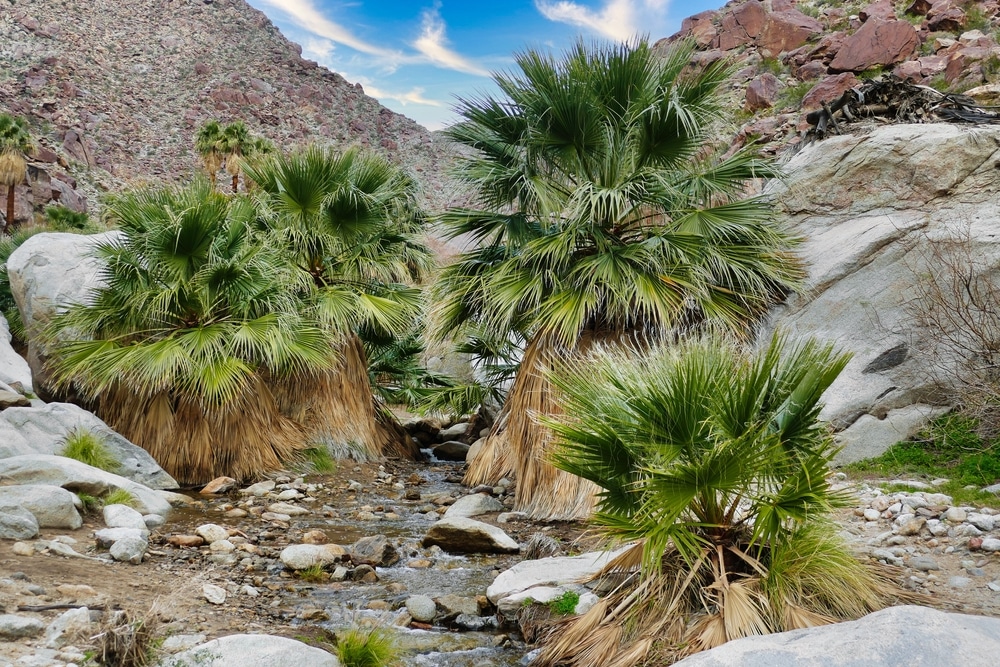
| California Fan Palm | Care Information |
|---|---|
| Origin | Mojave and Sonoran deserts |
| Plant size | 20 feet (6 meters) tall |
| Flowering | White small flowers |
| Light | Full sun |
| Watering | Minimal |
| Fertilizer | None |
| Potting soil | Moist sandy loamy soil that is well drained |
| Pruning | None |
| Repotting | Plant outside and give lots of space for growth |
| Toxicity | Edible seeds that feeds birds and other wild animals |
Bougainvillea
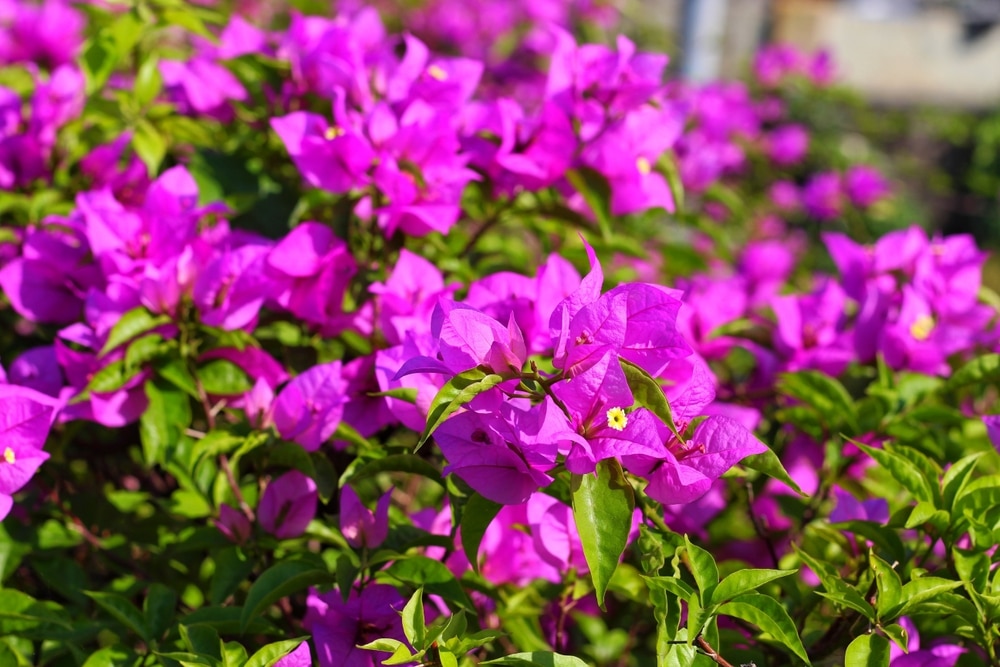
| Bougainvillea | Care Information |
|---|---|
| Origin | Brazil, Bolivia, Paraguay, Peru, and Argentina |
| Plant size | 20-30 feet (6-9.14 meters) tall and wide if supported |
| Flowering | Spring through autumn |
| Light | Full sun |
| Watering | Minimal watering |
| Fertilizer | None |
| Potting soil | Well drained sandy loam |
| Pruning | Prune new growth and shoots from last year in early spring. Only take 1/3rd of a branch |
| Repotting | Best out of pots. Replant in early spring if moving shrubs |
| Toxicity | Not toxic |
Mesquite Tree
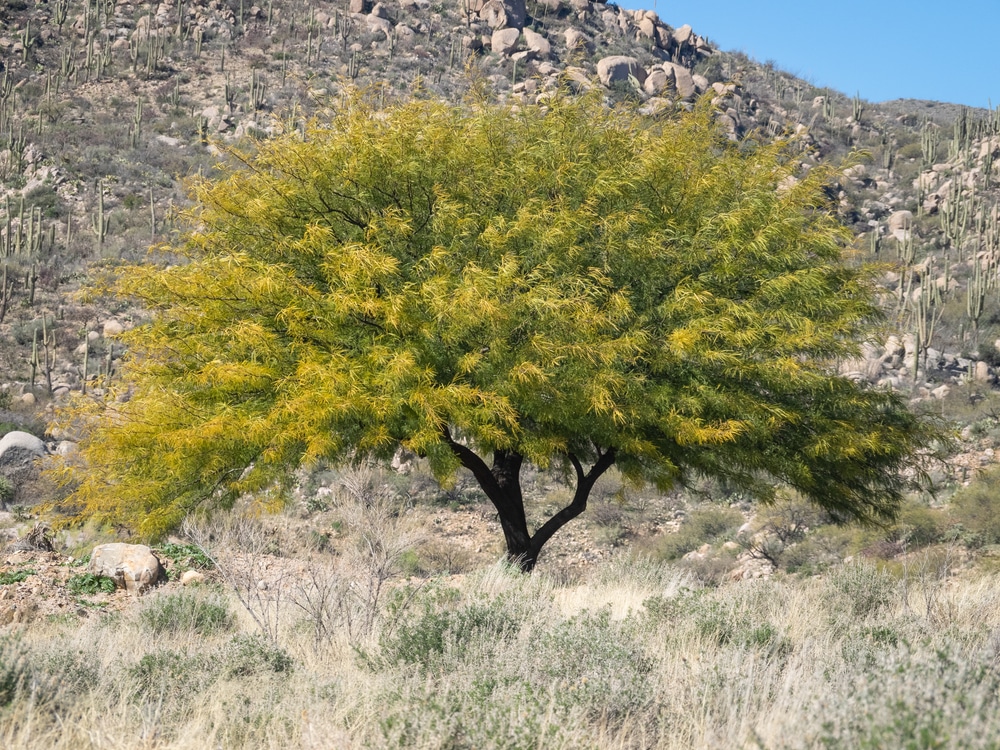
| Mesquite Tree | Care Information |
|---|---|
| Origin | Most of the South West |
| Plant size | 20-50 feet (6-15.24 meters) tall |
| Flowering | Flowers bloom in spring and summer. Flower colors range from green to yellow |
| Light | Full sun |
| Watering | Minimal |
| Fertilizer | None |
| Potting soil | Well drained sandy soil |
| Pruning | Need yearly pruning to maintain shape and to keep under control |
| Repotting | Best out of a pot. Very hard to replant as the tree grows very fast and has a deep tap root |
| Toxicity | Edible beans seed pods |
Whitethorn Acacia
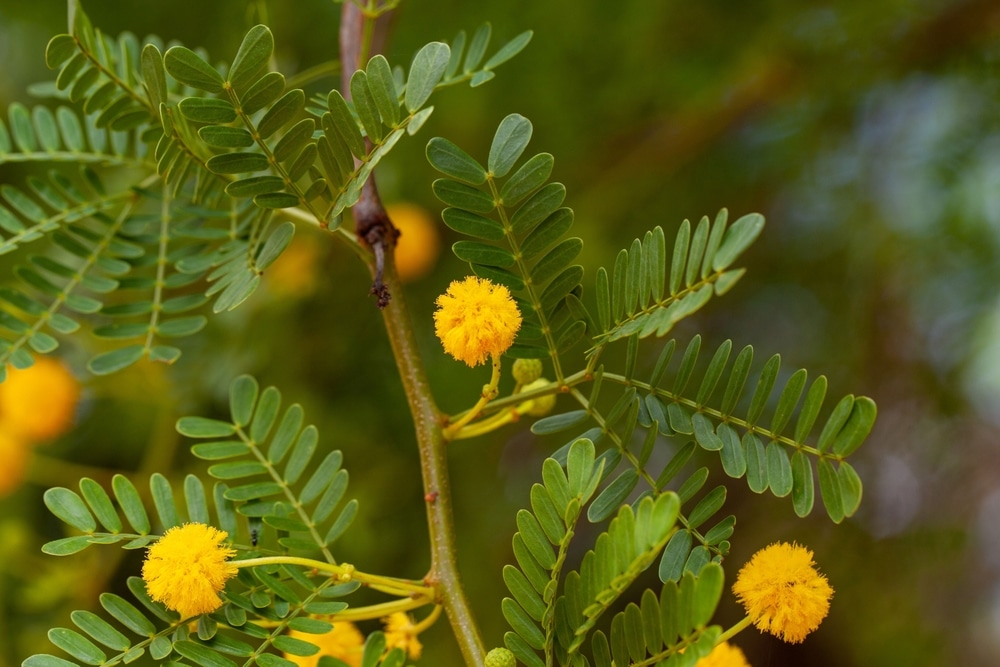
| Whitethorn Acacia | Care Information |
|---|---|
| Origin | Arizona, New Mexico, Texas |
| Plant size | 19 feet (5.8 meters) tall |
| Flowering | Yellow, puff ball flowers. Sweet smell at night |
| Light | Full sun |
| Watering | Minimal |
| Fertilizer | None |
| Potting soil | Well drained sandy soil |
| Pruning | Prune in late winter or early spring to maintain form and shape! |
| Repotting | Best not to grow in a pot. Replant in spring |
| Toxicity | Yes, toxic to humans and animals |
Crape Myrtle

| Crape Myrtle | Care Information |
|---|---|
| Origin | Asia |
| Plant size | 20-20 feet (6-9.14 meters) tall |
| Flowering | Late spring through summer |
| Light | Full sun |
| Watering | Once a week |
| Fertilizer | Organic all-purpose, well-balanced fertilizer. Apply every three weeks during the growing season |
| Potting soil | Well drained soil with compost |
| Pruning | Flowers grow on the new growth of the crape myrtle. pruning should be done prior to new growth, in late winter |
| Repotting | Should be grown in the garden and are hard to replant once roots have developed |
| Toxicity | Non-toxic |
Joshua Tree
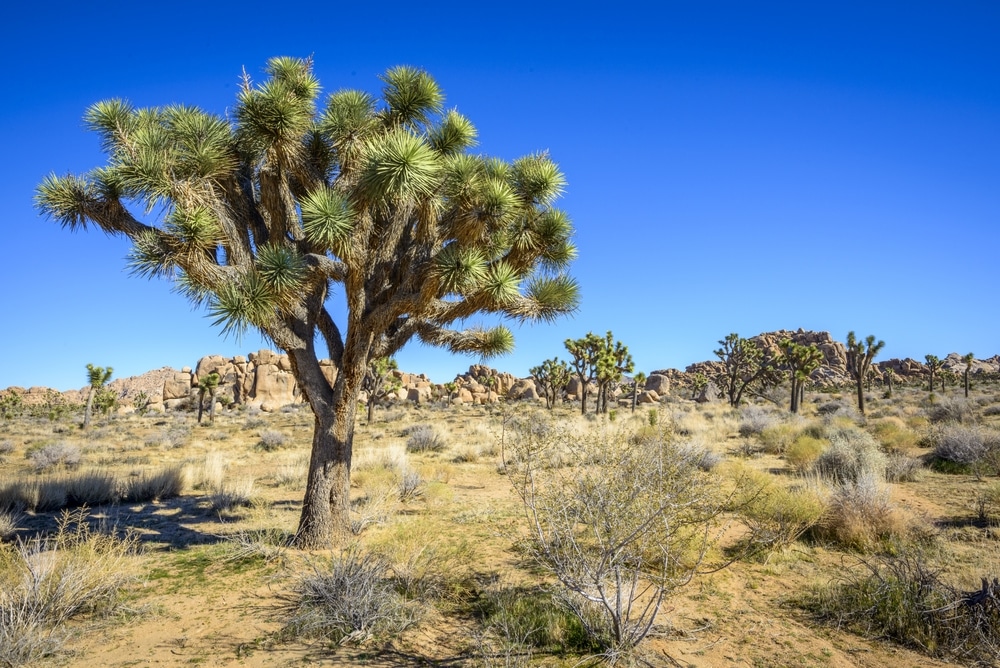
| Joshua Tree | Care Information |
|---|---|
| Origin | Mojave Desert |
| Plant size | 15 feet (4.57 meters) tall |
| Flowering | cream-white to yellow-green flowers, blooming in the spring. They have a sour scent |
| Light | Full sun |
| Watering | Minimal |
| Fertilizer | None |
| Potting soil | Sandy well drained soil |
| Pruning | None |
| Repotting | Slow grower |
| Toxicity | Toxic to humans and animals |
Desert Lavender
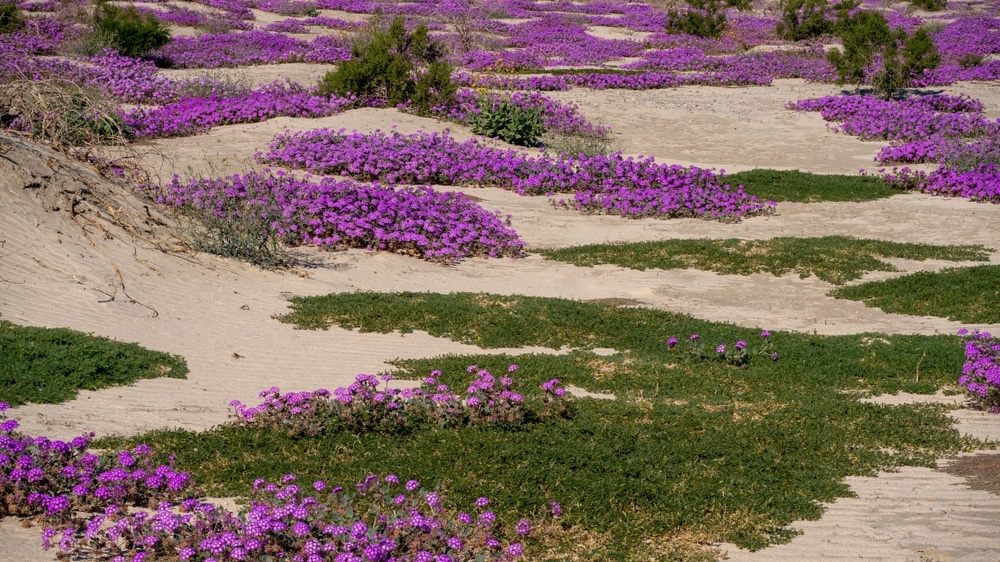
| Desert Lavender | Care Information |
|---|---|
| Origin | Sonora, Baja, California |
| Plant size | 10 feet (3.05 meters) tall |
| Flowering | Sweet smelling, spring blooming, violet flowers |
| Light | Full sun |
| Watering | Water deeply in the summer season and allow it to dry out completely before deep watering again |
| Fertilizer | None |
| Potting soil | Sandy, well drained soil |
| Pruning | Prune in late summer, aftering flowers are spent |
| Repotting | Replant in spring |
| Toxicity | Non toxic |
Creosote Bush
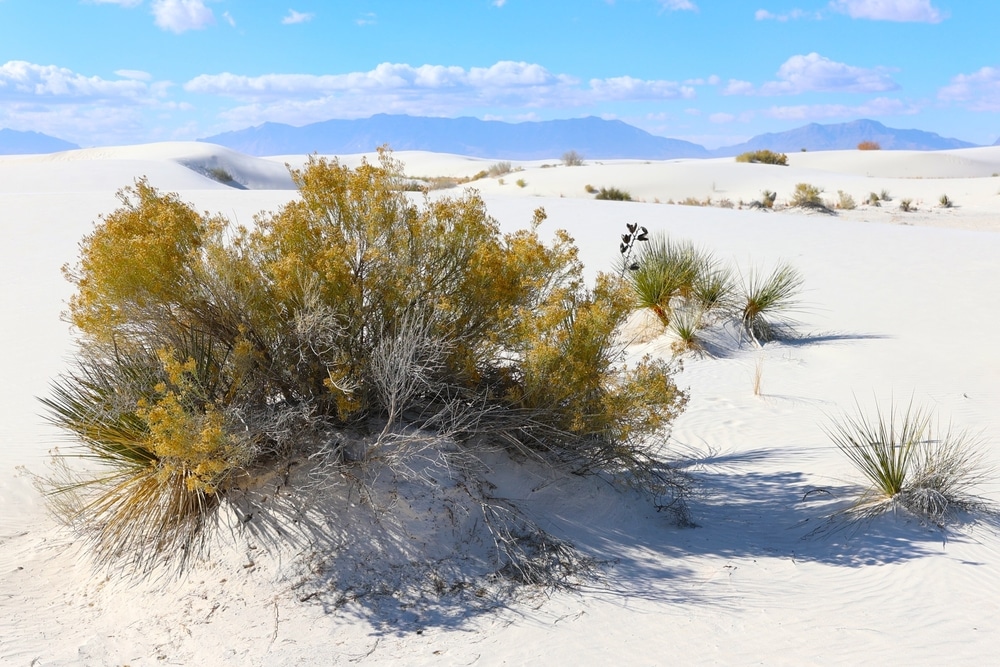
| Creosote Bush | Care Information |
|---|---|
| Origin | Southwestern desserts of Utah, Arizona, California, Mexico, Texas |
| Plant size | 3-10 feet (0.9-3 meters) tall |
| Flowering | Yellow flowers bloom February to August. Will hold its flower most of the year |
| Light | Full sun |
| Watering | Minimal |
| Fertilizer | None |
| Potting soil | Well drained sandy soil |
| Pruning | Prune in early spring to maintain shape |
| Repotting | Transplant in late winter |
| Toxicity | Toxic to human and animals |
Desert Flower Varieties:
California Poppy
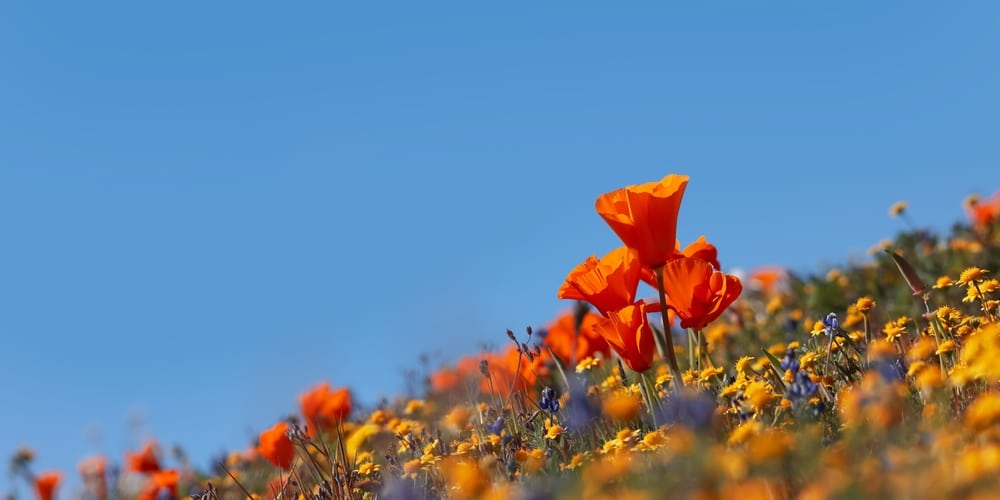
| California Poppy | Care Information |
|---|---|
| Origin | Western Oregon to Southern California |
| Plant size | 6-12 inches (15.24-30.48 centimeters) tall |
| Flowering | Bright orange flowers bloom in early summer |
| Light | Full sun |
| Watering | Minimal |
| Fertilizer | None |
| Potting soil | Sandy, well drained soil |
| Pruning | None |
| Repotting | No |
| Toxicity | Toxic to humans and animals |
Ghost Flower
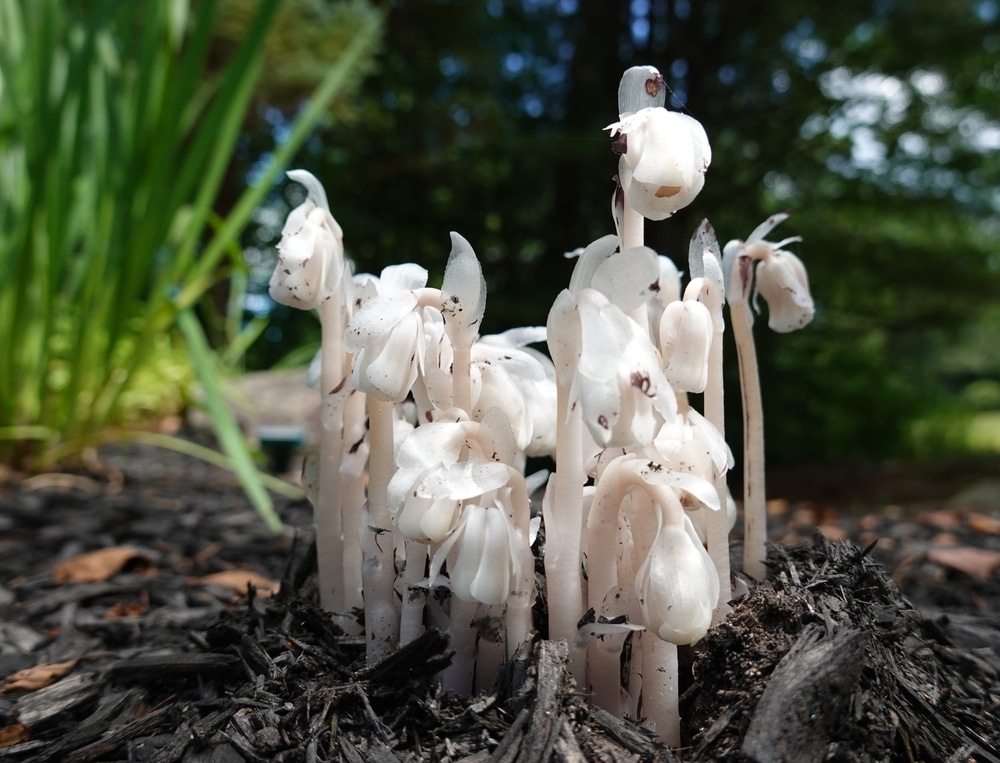
| Ghost Flower | Care Information |
|---|---|
| Origin | Nevada, Arizona, California |
| Plant size | 10 inches (25.4 centimeters) tall |
| Flowering | Translucent pale cream |
| Light | Full sun |
| Watering | Minimal |
| Fertilizer | None |
| Potting soil | Well drained sandy soil |
| Pruning | None |
| Repotting | Repot in spring |
| Toxicity | Toxic to humans and animals |
Desert Marigold
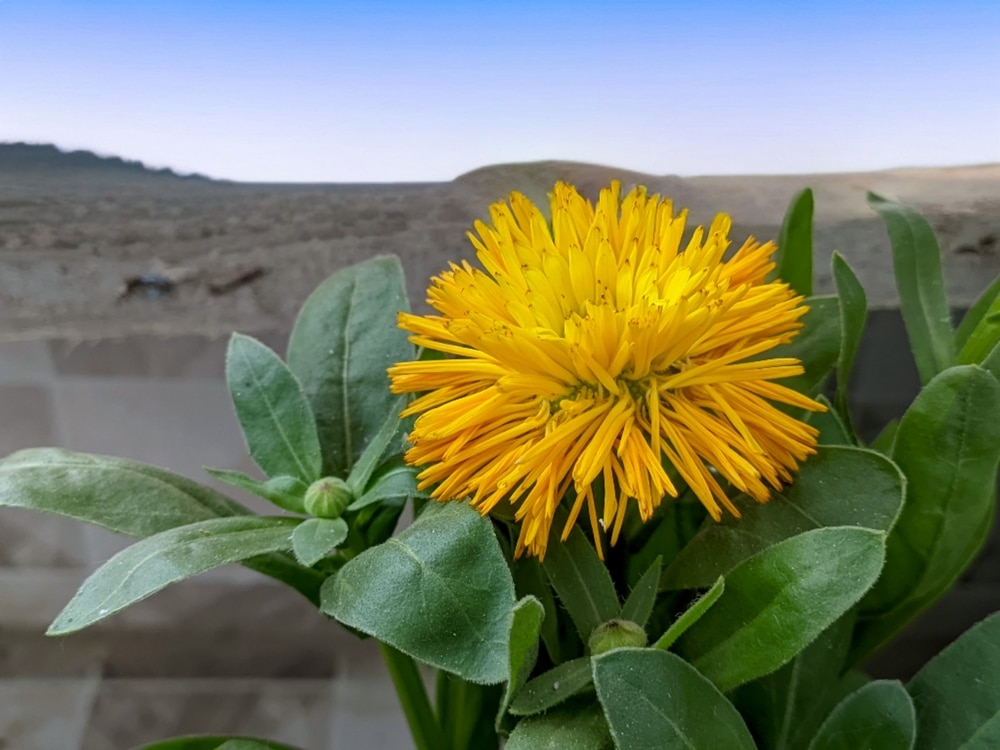
| Desert Marigold | Care Information |
|---|---|
| Origin | Arizona, Nevada, Utah, Mexico and Texas |
| Plant size | 10 inches (25.4 centimeters) tall |
| Flowering | Yellow flowers bloom March – November |
| Light | Full sun |
| Watering | Minimal |
| Fertilizer | None |
| Potting soil | Well drained Sandy or rocky soil |
| Pruning | None |
| Repotting | No |
| Toxicity | Brown seeds edible by birds |
Yellow Nightshade

| Yellow Nightshade | Care Information |
|---|---|
| Origin | Deserts of western North America |
| Plant size | 32 inches (81.28 centimeters) |
| Flowering | Bell shaped, bright yellow flower |
| Light | Full sun |
| Watering | Minimal |
| Fertilizer | None |
| Potting soil | Well drained |
| Pruning | None |
| Repotting | Every 1 to 2 years |
| Toxicity | Poisonous, Highly Toxic |
Desert Willow
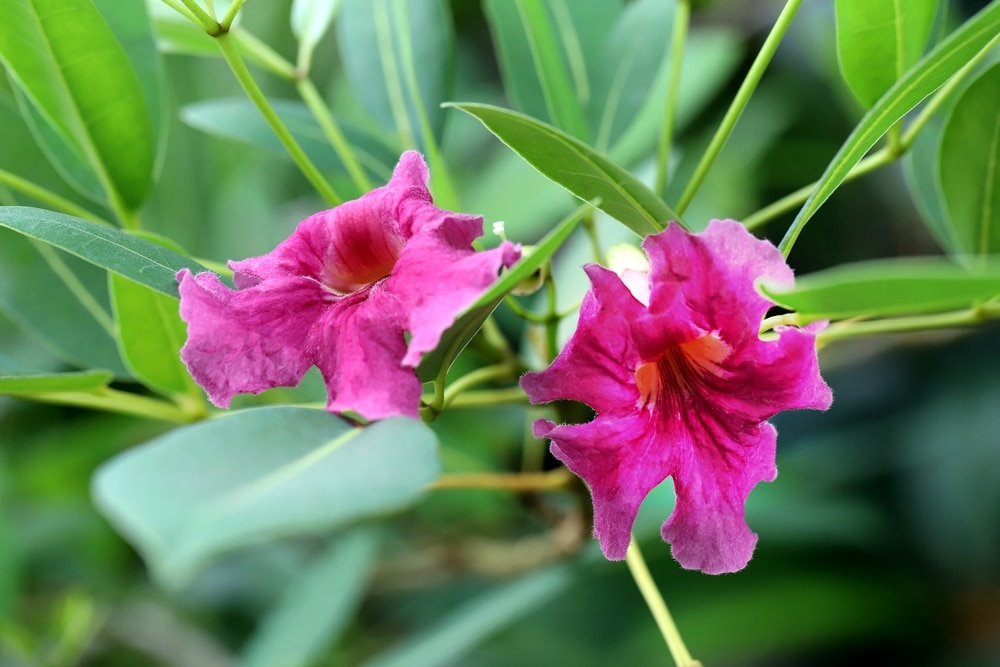
| Desert Willow | Care Information |
|---|---|
| Origin | California |
| Plant size | 18 feet (5.49 meters) tall |
| Flowering | Light purple |
| Light | Full sun |
| Watering | Once a month |
| Fertilizer | None |
| Potting soil | Rocky slopes |
| Pruning | Prune back late winter, early spring |
| Repotting | Replant in the fall. Doesn’t do well grown in pots |
| Toxicity | Non-toxic |
Brittlebush

| Brittlebush | Care Information |
|---|---|
| Origin | Southwestern USA, Northern Mexico |
| Plant size | 2-5 feet (0.61-1.52 meters) tall |
| Flowering | Purple, orange, and yellow daisy-like flowers. Bloom time March to May |
| Light | Full sun |
| Watering | Water when soil is dry |
| Fertilizer | None |
| Potting soil | Rocky, gravel soil |
| Pruning | Prune late in spring to keep shape |
| Repotting | Replant in fall. Not suggested to grow in pots |
| Toxicity | Non-toxic |
Desert Lily
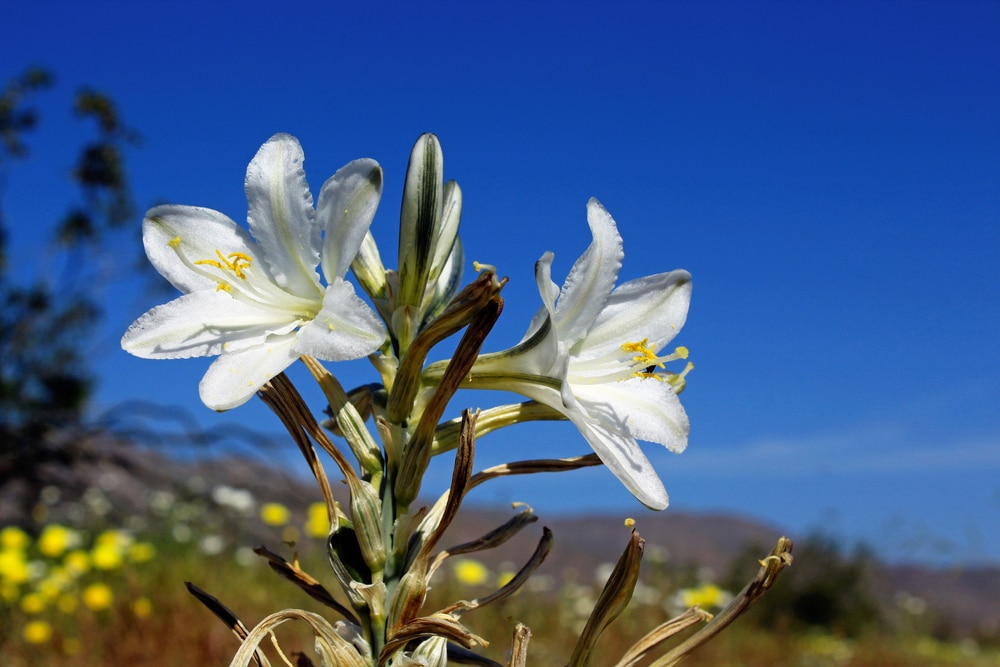
| Desert Lily | Care Information |
|---|---|
| Origin | Mojave and Sonoran deserts |
| Plant size | 4 feet (1.22 meters) tall |
| Flowering | Cream flowers that that a sweet smell |
| Light | Full sun |
| Watering | Minimal |
| Fertilizer | None |
| Potting soil | Well drained sandy loam |
| Pruning | None |
| Repotting | After blooming in early summer |
| Toxicity | Toxic to humans and animals |
Desert Grevillea
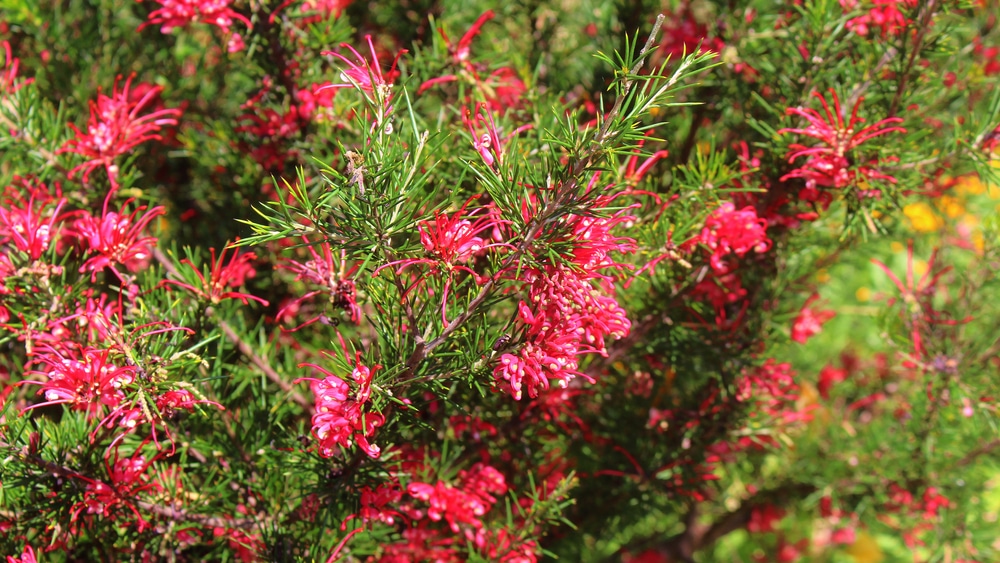
| Desert Grevillea | Care Information |
|---|---|
| Origin | Australia |
| Plant size | 3-4 feet (0.91-1.22 meters) tall |
| Flowering | Blooms in spring |
| Light | Full sun |
| Watering | Minimal |
| Fertilizer | None |
| Potting soil | Well drained sandy soil |
| Pruning | Cute back late winter, early spring |
| Repotting | Replant in fall. Not recommended for pots |
| Toxicity | Toxic to humans and animals |
Desert Senna
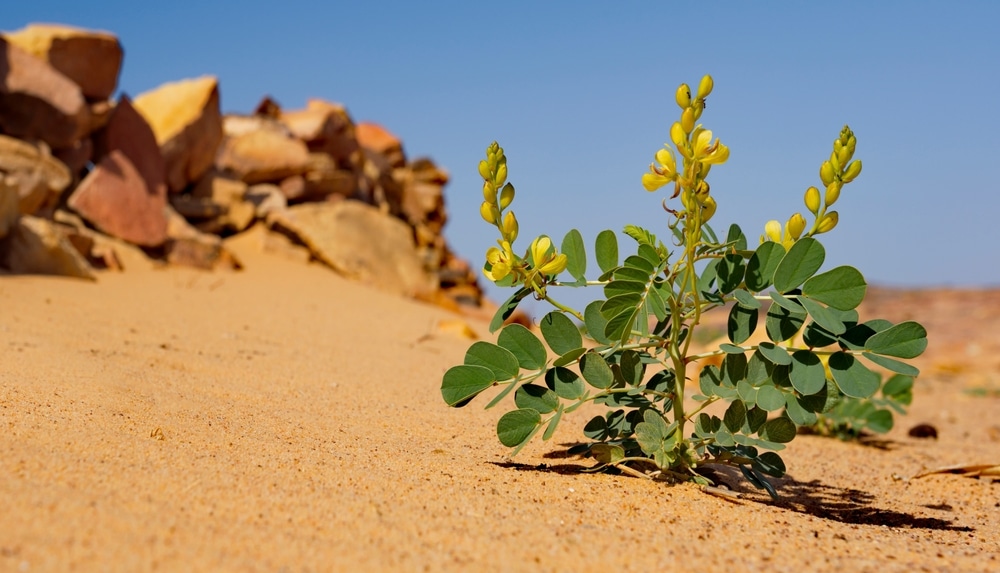
| Desert Senna | Care Information |
|---|---|
| Origin | Mojave Desert, Sonoran Desert in California, Nevada, and Arizona and northern Mexico. |
| Plant size | 2 feet (0.6 meters) tall |
| Flowering | Yellow blooms April through October |
| Light | Full sun |
| Watering | Minimal |
| Fertilizer | None |
| Potting soil | Sandy, well drained soil |
| Pruning | None |
| Repotting | Repot in spring |
| Toxicity | Toxic to animals and human |
Mexican Poppy
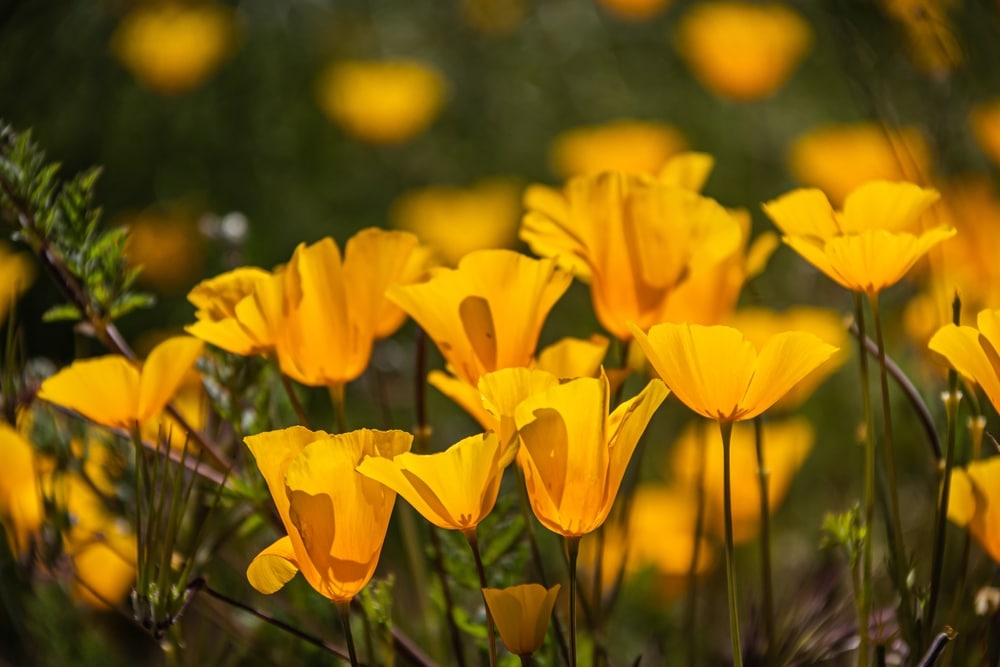
| Mexican Poppy | Care Information |
|---|---|
| Origin | Arizona, New Mexico, California, Texas, Colorado, Utah and Nevada |
| Plant size | 8-18 inches (20.32-45.72 centimeters) |
| Flowering | Yellow blooms February through May |
| Light | Full sun |
| Watering | Minimal |
| Fertilizer | None |
| Potting soil | Well drained, sandy and gravel soil |
| Pruning | None |
| Repotting | Repot in fall |
| Toxicity | Toxic to humans and animals |
Benefits And Uses Of Desert Plants
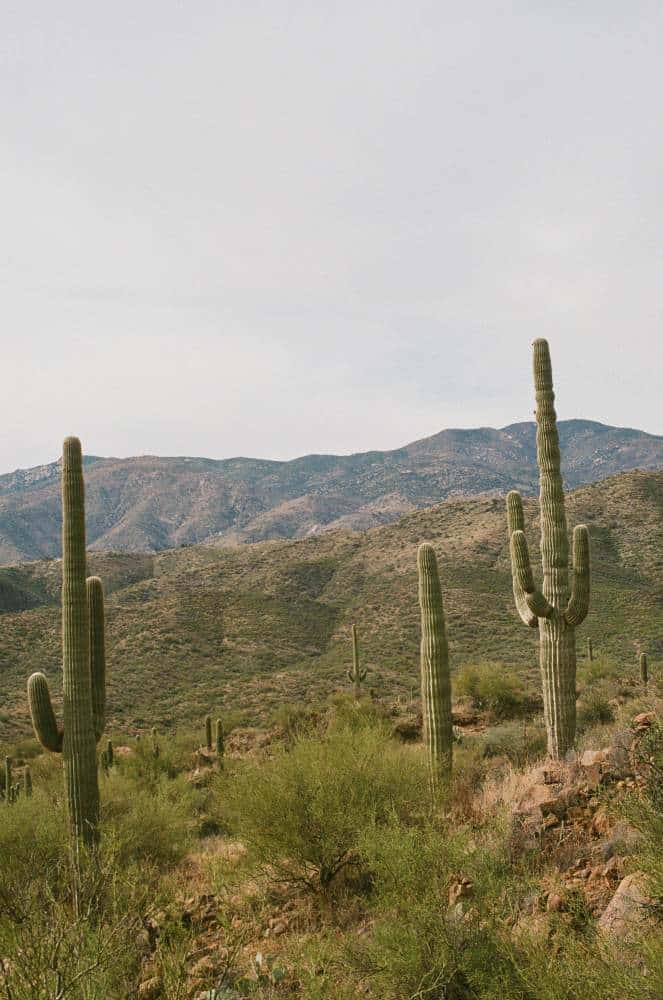
Wildlife Habitat
Desert plant species support many desert animals. A wonderful example of this is the Saguaro Cacti. The Saguaro Cacti are keystone species, meaning many forms of wildlife depend on these plants to survive. They provide food and shelter to desert animals including a variety of:
- Birds
- Bats
- Honey bees
- Various mammals
They support bird species by providing them with nesting habitat & food sources. Gila woodpeckers will excavate holes in the prickly cactus skin to make nests. They excavate new holes each year, continually providing a variety of other birds and mammals with vacant holes to nest in. Mammals like the bobcat will use the cacti to perch on top to rest and hunt. Some birds that use the saguaro cactus are:
- Elf owls
- House finches
- Flycatchers
- Purple martins
Herbal Medicines
Many desert plants have medical properties. Plants like aloe vera have been used for generations to cool burns and soothe the skin. Soaptree yucca has roots that are used to make soap. Creosote bush leaves were chewed and used for healthy oral hygiene. It was also used as a treatment for toothaches, dandruff, and even fevers by the local indigenous peoples.
Landscaping With Desert Plants
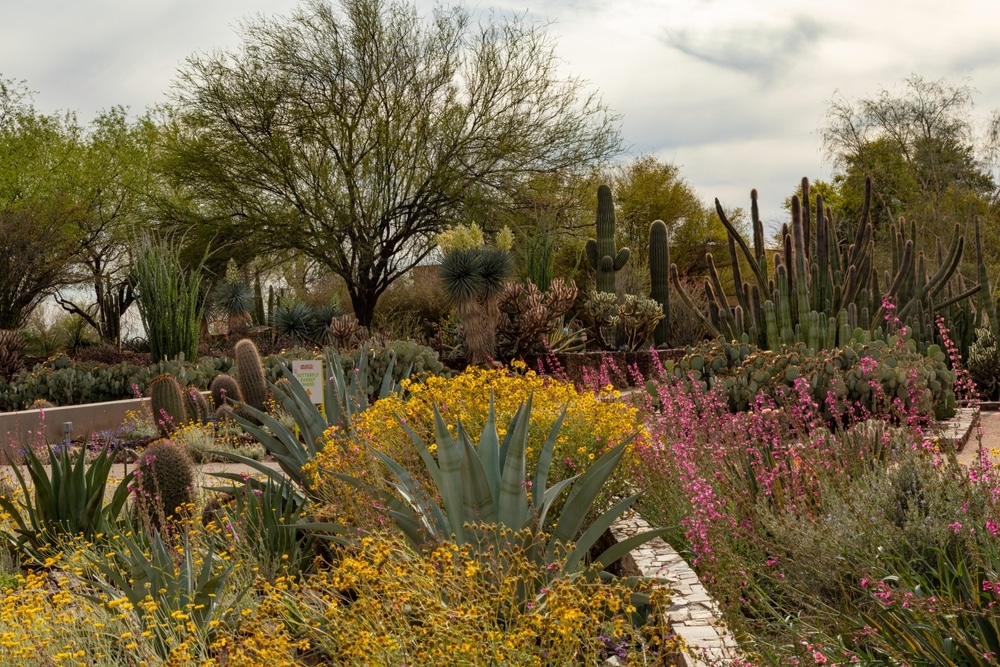
Landscaping with desert plants is one of my favorite design themes. These specialized plants can be impactful, eye-catching, and wildlife-friendly! They are low maintenance and drought tolerant.
An important aspect of desert plant gardens is being aware of what plant species can survive in the area you live. As we have learnt, these are specialized plants that require certain habitat requirements to thrive! Understanding your hardiness zone and the hardiness zones each plant can survive in, is your key to creating a successful desert landscape.
Popular Desert Plants For Landscaping
Yucca
Yucca is a great filler plant for the garden. It is short and stout, with a long flowering spike that stands off the ground when flowering. It is evergreen and if planted strategically throughout the garden, can be a great plant, adding cohesive flow throughout the space.
Desert Grevillea
Desert grevillea is a great shrub for your garden. An added benefit is that it provides hummingbirds with a food source! This shrub is also evergreen, adding structure and color all year in the garden.
Crape Myrtle
Crape myrtle is a great statement tree. They bloom for most of the summer and come in a variety of colors, including pink, dark pink, purple, and white. Plant them close together to create quite the decorative hedge row. They have unique paper bark and smaller leaves. They add a delicate touch to any garden.
California Poppies
California poppies make a great ground cover. They self-seed and are quite impactful when there is a mass group all in bloom. Make sure you are in an area where California poppies are native. This plant has invasive tendencies and is good at spreading!
Prickly Pear Cactus
For our colder climates, Prickly pear cactus is a great addition to a desert plant garden. These cacti are cold-tolerant and are found all over North America. They have big pads with beautiful flowers and look lovely in a mass planting on rocky outcrops.
Design Tips For Desert Landscapes
Height is an important factor with desert plants, and most are slow-growing. Place taller plants along the back edge of the garden bed. Plants arranged in groups of 3, 5, or 7 follow basic design principles that create a fuller, more aesthetically pleasing look in the garden.
Do you want to include your favorite desert plant but live in the wrong climate? Trying planting in pots! Keep them in your yard all summer and bring them inside once the winter gets cold. Make sure you feel your plants in a full sun, south-facing window.
How To Grow & Care For Desert Plants
Below you will find generally guidance on desert plants’ basic needs. For more detailed information on the different species’ requirements, please refer to the individual information tables above.
Sun
Desert plants like it hot! These types of desert vegetation require full sun. It’s important to place dessert plants in areas that will receive 6+ hours of sunlight (if not more) daily.
Soil
Optimal soil conditions for desert plants are drained sandy soil. If you want to incorporate desert plants into your garden space or are having trouble with drainage problems, try mixing sand or gravel into the soil.
Water
Water plants deeply but less frequently. Like in a natural desert ecosystem, when it rains, it pours. Water plants deeply and then drought. Try watering once a month and allowing the plants to completely dry out before watering again. Over-watering cacti kills them faster than underwatering them. Remember that!
Hardiness Zones
An important aspect of desert plant gardens is being aware of what plant species can survive in the area you live. As we have learnt, these are specialized plants that require certain habitat requirements to thrive! Understanding your hardiness zone and the hardiness zones each plant can survive in, is your key to creating a successful desert landscape.

